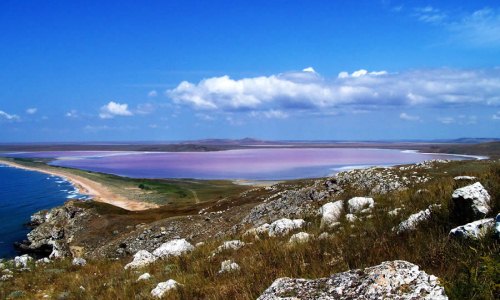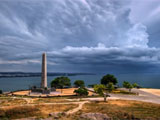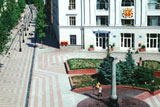Ancient and modern Kerch

Kerch is a city of traditions as old as centuries. It solemnly celebrated its 2600-th anniversary in September 2000.
Panticapaeum, Bosporus, Caesaria, Karkh, Kortchev, Cherkio, Kersh this list of names is far from being complete. Among the historical and cultural sights of Kerch one can find memorials of various epochs, beginning with early antiquity. They include burial mounds and crypts, ancient sites and rural settlements, curt buildings and obelisks, monumental sculptures and architectural constructions.
The history of this multi-national city is symbolically reflected in its emblem and flag. The central element of the city emblem is the gryphon, a fantastic winged animal, a kind of bird with a lion’s body and an eagle’s beak. The gryphon has been a popular symbol for 5000 years; its origin is in Mesopotamia. At the beginning of the 1 st millennium ВС, the image of the gryphon appeared in ancient Greece and later in Bosporus. In due course, the eagle-headed gryphon became the emblem of Panticapaeum. It was depicted either on its own, or in combination with a sturgeon or a wheat ear.

In ancient Greek mythology the gryphon was considered as a symbol of power and vigilance, guarding against evil and demonic forces. As a symbol of the sun, the gryphon was devoted to Apollo, the god of light and all the arts and the patron of ancient Kerch. The gryphon served this solar deity and drew his chariot in the sky. A majestic temple devoted to Apollo was erected by the city dwellers on the acropolis of Panticapaeum.
During the first half of the 19th century, Russian Kerch appeared on the site of Panticapaeum. It inherited the heraldic symbols of this place. The first city emblem, confirmed in November 17, 1844, had an image of the gryphon guarding a key. The key symbolized the entrance from the Black Sea into the Sea of Azov. Due to the status of the Kerch-Yenikale region, the emblem was adorned with the Imperial Crown.
In the modern emblem of the hero-city of Kerch, the gryphon is depicted on a shield of the French style. It still guards the key, the symbol of control over the Kerch Strait. The red color of the shield symbolizes love, courage, bravery, and generosity. The golden color means wealth, exalted status, virtue and justice. The oak branches on the wreath represent solidity and power, the laurel branches symbolize victory, glory and honor. The red ribbon in the wreath is of the Alexander Nevsky Order. Such a ribbon should have been included into the emblem of Kerch at the end of the 19th century. But this was not realized at that time. The blue ribbon is of the St. Andrew Order and commemorates the apostle’s visit to the city of Bosporus. From this very place his holy mission to Taurida began. On September 14, 1973, Kerch was awarded with the Order of Lenin as a hero-city. However, due to political motives, the ribbon of the Order of Lenin, was not included into the city emblem.
Kerch was the first city of the Crimea joined to Russia in 1774 under the Kuchuk-Kaynardzhy Treaty. Since then, the Imperial Crown is a symbol of Kerch as a Russian property.
Kerch is a city of two seas. Shipbuilding and ship-repairing, its trade and fishing-port, which play an important part in the city’s economy, are symbolized by the emblem of the admiralty anchors.
 The «Golden Star» medal of the hero-city is a symbol of the heroic events during World War II. It is also a reminder that Kerch belongs to the group of others Russian, Ukrainian and Belarusian hero-cities.
The «Golden Star» medal of the hero-city is a symbol of the heroic events during World War II. It is also a reminder that Kerch belongs to the group of others Russian, Ukrainian and Belarusian hero-cities.
The emblem of Kerch with the symbol of the gryphon may be considered as one of the most ancient emblems in Europe.
The modern city flag is the-first one in the history of Kerch. It bears red and white alternating stripes. These colors are characteristic of the Russian and the Crimean flags. The red color symbolizes bravery and courage and is the color of the blood shed for the land. Its white color symbolizes faithfulness and purity of intentions; it is also a symbol of water. The alternating red and white stripes resemble the laying of the walls of St. John the Baptist’s Church (an ancient and sacred place in Kerch) with the four rows of plinths on white lime.
The author offers one more explanation of the flag symbols. The four red stripes are equal to the number of the main periods in the history of Kerch: ancient times, the Middle Ages, the Renaissance and modern times. They are also equal to the number of four main ethnic communities who have inhabited the city at different historical periods: the Scythians, the Greeks, the Turks and the Eastern Slavs. It’s a pity that the Italians (Venetians and Genoese) are not included in the group mentioned. They have also greatly contributed to the development of the city.
The symbolic nature of the emblem and the flag demonstrates self-sufficiency and self-determination as of Kerch the most ancient city of Eastern Europe.
Похожие статьи
Метки: ancient, city, Eastern Europe, Kerch, modern







Warning: count(): Parameter must be an array or an object that implements Countable in /var/www/u1372913/data/www/pantikapei.ru/wp-includes/class-wp-comment-query.php on line 405